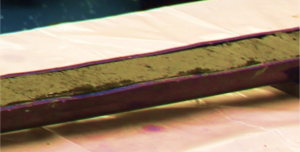by Thomas Kelly
Aboard the R/V Sikuliaq we often run around-the-clock operations and do our best to collect every last bit of data. Not only is our time limited, but ship time is valuable—really valuable. Even if you did manage to make the absolute most of the available ship time, there are inevitably gaps when the vessel is transiting from station to station, the equipment requires attention, or the weather limits safe science operations. This is where instruments that sample continuously come in handy. They record data all the time regardless of what the ship is or isn’t doing. Another benefit is the flow-through data is collected at no added cost to the science party since the ship records the data anyway.
I am particularly interested in using the seawater intake and flow-through systems to measure a variety of ocean parameters. The flow-through system pumps seawater from an intake on the hull and carries it through a series of different sensors. On the Sikuliaq, the flow-through system measures temperature, salinity and amount of Chlorophyll in the seawater. It does this 60 times a minute, nonstop, throughout the entire cruise. For our cruise that’s almost 1.3 million data points per sensor!
The flow through system is suitable for only some types of science because it measures seawater parameters at just one depth. However it does provide nice contextual information that can help frame the results of the other science happening on the ship. For example, consider this plot that shows the amount of Chlorophyll measured by the ship over the course of our cruise.

Figure 1. Plot showing the amount of Chlorophyll in the water over the course of our cruise. The ship set sail from Hawai’i on December 2 and arrives in San Diego December 17th.
Chlorophyll in aquatic systems, just like on land, is a rough measure of the amount of plants in the area. The figure above shows there was a substantial increase in Chlorophyll during the latter part of our cruise, which corresponds with our arrival to coastal California waters. Nutrient waters are present throughout this region, leading to blooms of phytoplankton (marine plants) such as the one we measured here.
High chlorophyll events like the one on December 12th occur frequently off of the coast of California, however it is not only is the water column that is packed full of organic matter (consider the large fishing industry here) but the sediments are as well. You can actually see the difference in the color of the cores we collected in the North Pacific Gyre (far from the coast) and in the California borderlands (near the coast).

This sediment core sample was collected off the coast of California. It is green because of organic material. Photo by Megan Roberts.

This sediment core was collected in the middle of the North Pacific Gyre and consists almost entirely of mineral dust. Photo by Jake Beam.
The flow-through system is one of a number of systems onboard that helps us to understand the world around us; in other words, helps us to do science.
